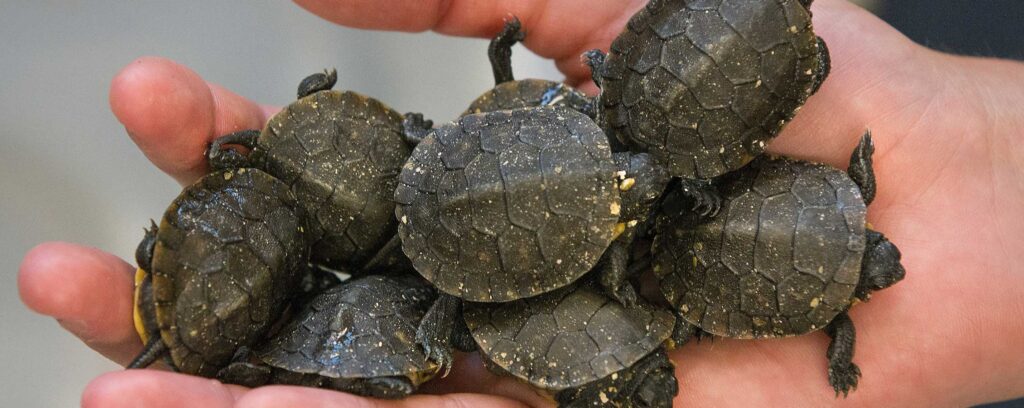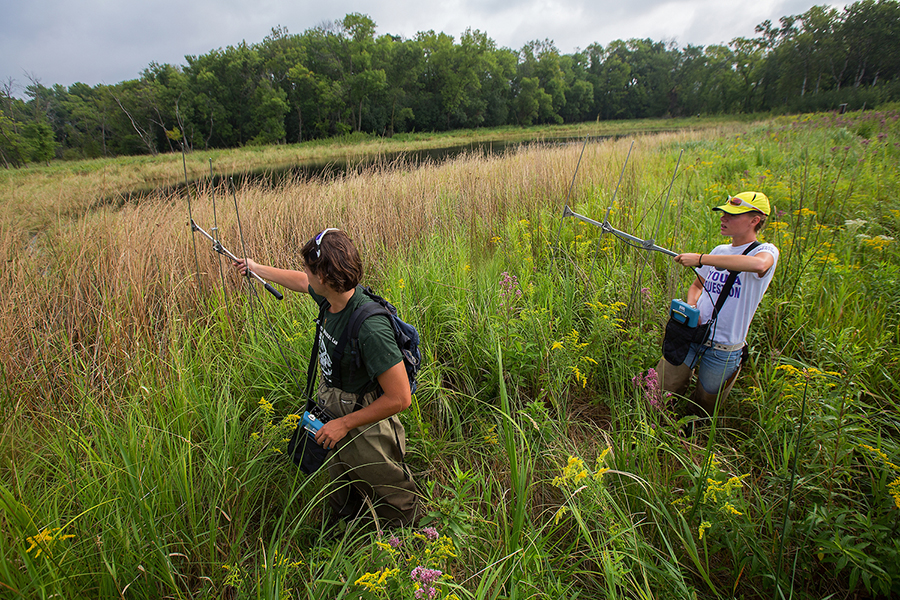
Blanding’s turtle hatchlings like these were hatched in captivity and released in a Rock County marsh as part of a multi-year study involving UW-Whitewater students of a conservation practice called “headstarting.” (UW-Whitewater photo/Craig Schreiner)
UW-Whitewater students Nick Rudolph and Lisa Mitchem start their day at a reclaimed marsh in Rock County. They unpack research equipment from their car and don fishing waders. Standing in shallow water are great blue herons and egrets trying to be incognito among the cattails.
This was an outdoor laboratory for Mitchem and Rudolph in 2014. Other undergraduate student researchers followed them in a multi-year, multi-state project led in part by Professor of Biology Joshua Kapfer. Along with graduate students and faculty from Northern Illinois University, they tracked Blanding’s turtle hatchlings to find out how well a conservation practice called “headstarting” improves hatchling survival. Their results were published in a June edition of the Journal of Herpetology.
The shy, yellow-flecked Blanding’s turtle is designated as a species of special concern by the Wisconsin Department of Natural Resources and is at risk across the Midwest due to the loss of its habitat. Raccoon populations rise where humans move in, and raccoons love to eat turtle eggs and soft newborns.
Kapfer and his students located nests, identified turtles that were about to lay eggs, collected eggs and hatched the eggs in captivity. The tiny hatchlings were fitted with chip-sized transmitters and released. Their NIU counterparts, working at sites west of Chicago and near Lake Michigan, deployed cages designed to keep out predators while allowing the new hatchlings to leave on their own.
“We wanted to know about headstarting and what happens to these turtles after they are released,” said Kapfer, noting that field research on headstarted turtles can lead to a better application of conservation practices, efficient uses of time and funding, and more Blanding’s turtles.
Their results showed that recently hatched turtles survive in greater numbers than Kapfer expected.
“Our original thought was that perhaps hatchlings were just as vulnerable as eggs,” said Kapfer. “Our work supports that hatchlings have pretty high survival. That is, they don’t get gobbled up right away.”
Kapfer attributes the research gap to the difficulty in studying tiny, tiny turtles. Carrying hand-held antennas and trekking through the muck, Kapfer’s students created a data picture of the movements and survival of the turtles they’d headstarted.
“Tracking turtles through wetland is very, very challenging work,” he said. “It’s physically demanding, mentally demanding. You have to be able to think under duress when you’re all hot and sweaty, covered with bugs and pushing through a wetland. You have to be able to make decisions.”
Students met landowners whose consent was needed when turtles crossed property lines. All of the work was done on private land with consent from owners.
Kapfer credited the research funding through the UW-Whitewater SURF program, Undergraduate Research Funds and the Provost’s Office with making summer research possible. With the help of these funds, students can be headstarting their own future careers with relevant summer jobs, he said.
“A huge goal of mine is not only to teach them, but to teach them how to be scientists,” he said. “That really is true across the board in the biology department. We’ve been very good at conducting real research that ultimately ends in students presenting at professional meetings or ultimately being co-authors on peer-reviewed publications.”
The alumni who tracked Blanding’s turtles through the marsh are excelling as teachers, consultants and graduate researchers. In May, Mitchem graduated with a doctorate from the University of Virginia. She said undergraduate research helped her see that a desire to study biology could be turned into a career as a scientist.
“Going into undergrad, I knew I wanted to study biology,” said Mitchem. “But I never imagined that a person could make a living by tracking turtles and asking cool questions about wildlife. My decision to go to grad school was definitely influenced by my experiences in research as an undergrad.”
Upon graduating from college, Karl Rutzen (’16) was hired to teach at West Allis Central High School near Milwaukee. At various times, Rutzen has taught biology, physical science and chemistry.
“Recently, we have started a move to more project-based learning,” said Rutzen. “The (Blanding’s turtle) project helped me realize that we need to learn more about all of the species around us, so I try to encourage all of the students I work with to be curious and keep asking why.”
Andrew Ibach and Joseph Mozuch, who are also former undergraduate researchers on the project, are working on graduate degrees at the University of Kentucky and at UW-Madison, respectively. Rudolph has worked at the DNR and in consulting, said Kapfer.
“At the end of the day,” Kapfer said using a favorite phrase, “We want to prepare students for the next level.”

UW-Whitewater students Nick Rudolph, left, and Lisa Mitchem search for radio signals from headstarted Blanding’s turtles fitted with transmitters. Dr. Joshua Kapfer, an assistant professor in the UWW Department of Biological Science describes the study: “Headstarting (rearing of eggs/juveniles in captivity to reduce predation rates) is a conservation tool frequently employed for turtles. Presumably, this technique increases turtle size, which makes them more difficult for predators to consume. However, limited research has assessed the effectiveness of this tool and the behavior of headstarted Blandingís turtles post-release. Our goal was to obtain this information by tracking turtle movements, habitat selection and assessing survival.” (UW-Whitewater Photo/Craig Schreiner)
